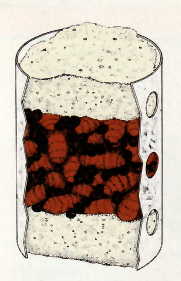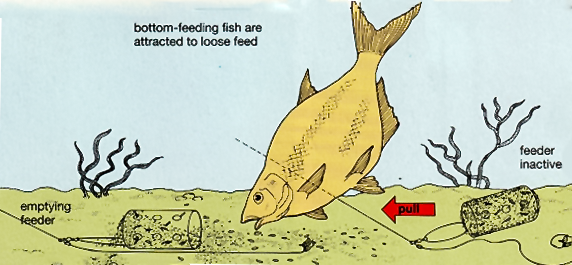...'fishing with feeders'
"The Swim Feeder is used for all species of coarse fish on all waters and is an
excellent method for feeding accurately at long range."
Swim Feeders - An Introduction
A swim feeder is a bait-holding container
attached to your line that gradually allows its contents to escape. It is
weighted so that it sinks quickly to the bed of the river or lake and stays
there.
You can fill the feeder with the same type
of bait that you are using on the hook and, because of its closeness to the
hook, this gives a very accurate means of feeding the swim. This is
particularly useful for fishing deep waters and fast-flowing rivers, where it
is difficult to ensure that hook bait and loose feed end up in the same place.
When to use a feeder
Whether to use a Feeder or not will depend upon the fishes'
feeding habits on the day and how far away the fish are.
Feeding Habits
Because the feeder is fished as a leger,
presenting a static bait on the bottom, there is no point using a feeder if the
fish are only feeding on the surface. Similarly, if the fish want a bait that
moves with the current it is better to float fish.
Distance
With the right tackle you can cast a feeder 46 - 55m
(50 - 60yd) or more. This is an advantage if fish are feeding at long range on
lakes or wide rivers; especially when conditions make it difficult to feed
accurately with other methods - such as catapulting.
Types of feeder
There are two types of Swim Feeder: the Open-end (with variations) and the Block-end. They can be used on still and running
waters.
Open-end Feeders
'Defensive' Approach

Small feeders are good for a
'defensive' approach when fishing is hard. In the past, the Swim Feeder was a crude 'hit or miss' form
of fishing - hence the nick-name 'Plastic Pig'. Today, Swim Feeder design and
techniques are far more refined.
Open-end Feeders are open at both ends. They are partially filled with maggots or
casters, or particle baits (hempseed or sweetcorn, for example) and the ends
plugged with Ground Bait. The bait is released in two ways:
-
some
escape through the holes in the Swim Feeder and,
-
the remainder is released as the Ground Bait plugs
dissolve within the Swim Feeder.
More recent variations are the cage and frame feeders. These are packed
with a mixture of Ground Bait and loose feed and are ideal for Bream, which
always appreciate a bit of Ground Bait.
Of the range of Open-end Swim Feeders, the cage feeder is a
good choice for Ground Bait. Another recent design, made of soft moulded
plastic, planes to the surface quickly on the retrieve - a good choice over 'weedy' or 'snaggy' bottoms.
Block-end Swim Feeders come in many
shapes, sizes and colours. Some have quick change, clip-on, non-toxic weights.
Others can be made Open-end by unscrewing the end cap. They are attached to the
line by swivel, stiff nylon link or a loop of heavy line. As a general guide,
you should choose the smallest, lightest feeder you can get away with.
Block-end Swim Feeders
Block-end feeders are closed at each end. The feeder is
filled by removing a cap at one end, and the bait is released solely through
the holes. Block-enders are normally filled with either Squatts, Pinkies or big Maggots which are able to crawl out of the holes. Casters and Hempseed can be
used if the flow is strong enough to wash them out, but on slow waters you may
need to enlarge the
holes in the feeder and twitch the rod occasionally to coax
the bait out.

Winding in a feeder that has not emptied properly is bad practice. It
deposits bait around the swim and disperses the fish, thereby defeating the
feeder's main object.
When filling an open-end feeder do not compress the Ground Bait too much, and avoid stodgy Ground Bait, which tends to stick to the
inside of the feeder.
Making sure it empties

Enlarging the holes
The holes in Block-end Swim Feeders can be enlarged to let the bait out
freely. Use a pair of scissors or a sharp blade to join two holes together.
Individual holes can be enlarged using a special tool. These are available from
tackle shops.
Choice of swim feeder
Both types of feeder come in a range of sizes and weights
from 1/4oz - 3oz (7g - 85g).
Whether you use the Block-end Feeder or Open end Feeder variety will depend
upon the type of bait you want to put in it. The important thing is that the
bait is able to get out.
It is worth bearing in mind that there are days (particularly in the
winter) when the fish are 'finicky' and will not be tempted by Ground Bait.
However, they may still be attracted by a few Maggots delivered by way of a 'Block-ender' rather than an 'Open-ender', which needs to be used with Ground Bait.
Weight
A feeder should carry enough weight to get the bait
where you want it and keep it there. On rivers, a stronger flow requires more
weight but don't overdo it. The ‘golden rule’ is to use just enough weight to
hold bottom.
Some feeders have fixed weights while others have interchangeable weights
which just slide off, making it easy to add or subtract weight to suit the
conditions.
Size
The size of feeder you choose usually depends on how
much bait you want to put out on each cast. But remember, bigger feeders are
more likely to shift with the current.
Bite indication
The feeder is fished as a leger, and you can use any of the
usual bite indicators. Quiver tipping is the most popular and probably the
simplest.
Most rods designed especially for 'feedering' (called 'Feeder Rods') have built-in quivertips.

Fill an Open-end Feeder with Hemp and Caster, and plug
each end with Ground Bait. This is ideal for Chub, Barbel and big Roach.
Rods and line for 'feedering'
It
is essential to get the right combination of rod and
line for 'feedering'.
Rods
Fast rivers, slow rivers and still waters make different demands on the Rod.
-
A Feeder Rod of 11ft or 12ft (3.3cm or 3.6m) is
good for all three types of water. Shorter
tip Rods are available but a longer Rod enables you to cast
with less effort and greater accuracy. It picks up line quicker on the strike
and gives greater control when playing fish (especially over troublesome
weed beds).
-
A Fast-river Rod should be fairly powerful (having a 'stiffish' butt) and
be capable of casting feeders from 1 1/2oz - 3oz (43g - 85g). It usually has a 'straight-through' (unspliced) tip section or a 'heavy-ish' Quivertip.
-
For Slow rivers you need a Rod with a
softer action and a 'spliced tip' section capable of casting feeders of about 1/2oz - 1oz (14g - 28g) or just over.
-
Stillwater Feeder Rods have an even
softer action with a soft quivertip capable of casting leads, or feeders from 1/4oz — 3/4oz (7g - 21g).
Tempting Trail


Get the Right Mix:
A few minutes after the Feeder has
settled, give a half turn of the Reel handle. This pulls the Feeder and Hook Length back, leaving a trail of attractive loose feed around the Hook Bait.
The
feeder empties better if you get the right mix of Ground Bait. The trick is to
mix it fairly dry. then when you cast it in, the Bait readily absorbs water and
virtually explodes from the Feeder.
Sometimes a heavier rod with a fine tip is useful. For example, on big
reservoirs long distance casting may require feeders of loz (28g) or heavier to
achieve the distance and get the feeder down quickly. This is where an extra Top Section with a Fine Quivertip is useful. When casting, the tip will fold over
and the 'meatier' part of the rod provides the long range casting power. The Fine Quivertip is then ready to register shy bites.
Line
You need a variety of breaking
strains from as low as 2 1/2lb (1. 1kg) for ultra-light feeders, to 6lb (2.7kg)
for feeders of around 3oz (85g). Your choice of breaking strain depends upon
the weight of feeder but you should aim to get away with the lowest without the
feeder cracking off on the cast.

When you are deciding on the Line strength,
remember that a Bait-filled Feeder may weigh twice as much as an empty one.
Holding bottom:
Remember that increasing the Line's diameter increases the line's
resistance to the flow, making it likely that your Feeder will be dragged out
of position.
Often, a lighter Feeder and lower breaking strain Line, such as 1 1/2
oz (43g) feeder to 51b (2.3kg) Line, holds bottom as well as a heavier Rig of
20z (57g) Feeder to 61b (2.7 kg) Line.
For Feeder Fishing you have a choice of two types of Feeder Rod. Some Rods have several top sections with a Quivertip permanently
spliced into each. Others take a selection of Push-in Tips, allowing you to
cope with a range of conditions. This system means you don't
need to pay for a whole section each time you need a new tip.

Keep a range of Tips of varying stiffness: a Soft Tip for shy biting,
canal and lake fish, and Stiffer Tips for when the flow is stronger. Feeder
weight and casting distance affect the choice of rod more than Tip.